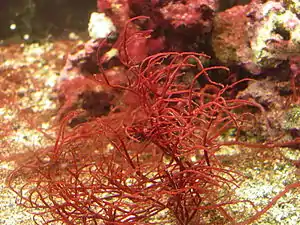Gracilaria
Gracilaria is a genus of red algae (Rhodophyta) notable for its economic importance as an agarophyte, as well as its use as a food for humans and various species of shellfish. Various species within the genus are cultivated among Asia, South America, Africa and Oceania.
| Gracilaria | |
|---|---|
 | |
| Scientific classification | |
| (unranked): | Archaeplastida |
| Division: | Rhodophyta |
| Class: | Florideophyceae |
| Order: | Gracilariales |
| Family: | Gracilariaceae |
| Genus: | Gracilaria Greville, 1830 |
Distribution
Gracilaria bursa-pastoris and Gracilaria multipartita have long been established in southern England and northwestern France, but confusion between Gracilaria gracilis and Gracilariopsis longissima, as Gracilaria verrucosa or Gracilaria confervoides, has hindered the accurate recognition of its northern distribution boundaries.[1]
Use

Gracilaria is used as a food in Japanese, Hawaiian, and Filipino cuisine.[2] In Japanese cuisine, it is called ogonori or ogo. In the Philippines, it is called gulaman and used to make gelatin.[3] In Jamaica, it is known as Irish moss.[4]
Gracilaria oligosaccharides with degree of polymerization 6 prepared by agarase digestion from agar-bearing Gracilaria sp. polysaccharides have been shown to be an effective prophylactic agent during in vitro and in vivo experiments against Japanese encephalitis viral infection. The sulfated oligosaccharides from Gracilaria sp. seem to be promising candidates for further development as antiviral agents.[5]
Aquarium trade
Gracilaria commonly appears as a macroalgae for sale in the aquarium trade. It is a highly palatable algae to tangs[6] and many other herbivorous fish, and its nutrient uptake ability makes it a suitable choice for a refugium.
Ecology
Gracilaria are susceptible to infection by the parasitic oomycete Pythium porphyrae.[7]
References
- Steentoft, M. and Farham, W.F. 1997. Northern distribution boundaries and thermal requirements of Gracilaria and Gracilariopsis (Gracilariales, Rhodophyta) in Atlantic Europe and Scandinavia. Nord. J. Bot. 5: 87–93
- Kyaw, Aye, The Production of Gracilaria eduli in Burma, Report of the Training Course on Gracilaria Algae, Manila, Philippines, 1–30 April 1981, accessed 27 April 2013
- Davidson, Alan (2004). Seafood of South-East Asia: A Comprehensive Guide with Recipes. Ten Speed Press. p. 197. ISBN 978-1-58008-452-9.
- Thomas J. Goreau; Robert Kent Trench (2013). Innovative Methods of Marine Ecosystem Restoration. CRC Press. pp. 193–. ISBN 978-1-4665-5773-4. Retrieved 30 June 2013.
- Kazłowski B, Chiu YH, Kazłowska K, Pan CL, Wu CJ (August 2012). "Prevention of Japanese encephalitis virus infections by low-degree-polymerisation sulfated saccharides from Gracilaria sp. and Monostroma nitidum". Food Chem. 133 (3): 866–74. doi:10.1016/j.foodchem.2012.01.106.
- Volynkin, Alex (2013-09-28). "Growing Gracilaria Parvispora". Salt Water Reefing. Retrieved 2016-12-18.
This brings me back to Achilles’s diet. The guy apparently really likes Gracilaria macro algae. No wonder, especially considering that the grass is indigenous to Hawaii as well, and is considered the favorite food for tangs.
- Spencer, M. A. (2004). "Pythium porphyrae. (Descriptions of Fungi and Bacteria)". IMI Descriptions of Fungi and Bacteria. 162 (Sheet 1617). Retrieved 10 October 2017.
A description is provided for Pythium porphyrae. Information is included on the disease caused by the organism, its transmission, geographical distribution, and hosts. DISEASES: Red-rot disease, red-wasting disease. HOSTS: Bangia atropurpurea, Callophyllis adhaerens, Polyopes affinis (syn
| Wikimedia Commons has media related to Gracilaria. |
External links
- Gracilaria and its Cultivation (archived at the Internet Archive)
- Gracilaria in the Suria Link Sea Plants Handbook (archived at the Internet Archive)